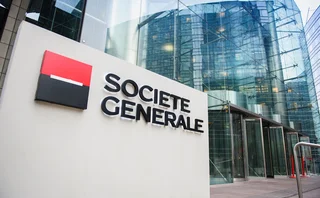
First SOFR swaps trade as banks test new benchmark
First OTC trades include two basis swaps and an OIS trade, with JP Morgan thought to be a counterparty

The first over-the-counter swaps linked to the new US secured overnight financing rate (SOFR) have been traded and cleared at LCH, in a landmark moment for the derivatives market. The trades follow a stark warning from the UK’s Financial Conduct Authority (FCA) that the market needs to speed up preparations for the possible death of the Libor reference rates.
The first trade was a SOFR-versus-Fed-Funds basis swap arranged by TP Icap and executed on its swap execution facility. It printed at 12:57pm New York time on July 16 and had a $50 million notional and one-year maturity, according to information from a swap data repository.
The trade was followed by a SOFR overnight indexed swap at 2:44pm and another SOFR-Fed Funds basis swap at 3:04pm. Both trades also had a notional of $50 million and a one-year maturity, but were executed off-venue.
The three trades were cleared at LCH on the first day its SOFR clearing service became available. It is thought JP Morgan was one of the counterparties to the trades. The bank declined to comment.
Two sources claim they were “pipe cleaner trades” designed to test the waters, but another source close to the trades denied they were tests.
Trading in SOFR swaps continued today (July 17), with BNP Paribas printing a SOFR OIS trade in the interdealer market.
Eric Duclos, head of US dollar flow rates trading at BNP Paribas in New York, says the bank wanted to print a SOFR trade as soon as possible to get comfortable with the process.
“We wanted to make sure we can trade and accommodate our clients’ needs the right way,” he says.
The three SOFR trades used the Fed Funds rate to discount the present value of future cashflows and to calculate interest on posted variation margin, in line with LCH’s previous decision to apply that rate to SOFR swaps in the short term. This approach has annoyed some market participants.
In contrast, CME – which is set to start clearing SOFR products from September, subject to regulatory approvals – will use SOFR for discounting and interest calculation, according to a spokesperson.
The trading and clearing of the first SOFR swaps represent the next stage in the evolution of the fledgling SOFR market. The index started printing a daily rate on April 3, while futures on the rate were launched on CME in early May.
SOFR is a measure of the cost of borrowing cash overnight, collateralised by US Treasuries. It includes tri-party repo trades, general collateral repo and bilateral trades cleared through the Fixed Income Clearing Corporation.
It was selected by the US Alternative Reference Rate Committee – an industry working group convened by the US Federal Reserve – last year as an alternative reference rate to US dollar Libor for interest rate contracts.
Disappearing Libor
In July last year, the UK FCA, which oversees US dollar Libor, said it would give up its power to compel banks to remain on the various Libor panels from the end of 2021, raising fears the rate could disappear at some point after that date.
The Fed is encouraging market participants to put new risk into SOFR swaps instead of US dollar Libor and to switch over their stock of legacy US dollar Libor swaps to reference SOFR, to prepare for Libor’s possible death.
Ice Benchmark Administration, the Libor administrator, is trying to persuade banks to continue submitting quotes to the panels after 2021 voluntarily, and at least two have indicated interest – leading some to believe Libor will survive for years to come.
However, earlier in July, FCA chief executive Andrew Bailey said the regulator would retain the power to pull the plug on a Libor rate after 2021 if there were not enough banks on the panel to provide quotes.
Update: After publication of this story, an LCH press release confirmed JP Morgan was a counterparty to the first trades, along with Goldman Sachs and Credit Suisse.
Editing by Olesya Dmitracova
Only users who have a paid subscription or are part of a corporate subscription are able to print or copy content.
To access these options, along with all other subscription benefits, please contact info@risk.net or view our subscription options here: http://subscriptions.risk.net/subscribe
You are currently unable to print this content. Please contact info@risk.net to find out more.
You are currently unable to copy this content. Please contact info@risk.net to find out more.
Copyright Infopro Digital Limited. All rights reserved.
As outlined in our terms and conditions, https://www.infopro-digital.com/terms-and-conditions/subscriptions/ (point 2.4), printing is limited to a single copy.
If you would like to purchase additional rights please email info@risk.net
Copyright Infopro Digital Limited. All rights reserved.
You may share this content using our article tools. As outlined in our terms and conditions, https://www.infopro-digital.com/terms-and-conditions/subscriptions/ (clause 2.4), an Authorised User may only make one copy of the materials for their own personal use. You must also comply with the restrictions in clause 2.5.
If you would like to purchase additional rights please email info@risk.net
More on Markets
Treasury clearing timeline ‘too aggressive’ says BofA rates head
Sifma gears up for extension talks with incoming SEC and Treasury officials
SG looks beyond equity derivatives in new markets push
French bank aims to expand fixed income business to achieve “more stable” revenues across asset mix
Does no-hedge strategy stack up for mag seven mavericks?
At Amazon, Meta and Tesla, the lack of FX hedging might raise eyebrows, but isn’t necessarily a losing technique
HKMA’s renminbi repo plans boost hopes for onshore access
Market participants optimistic that new provisions for offshore repos of onshore bonds is first step towards mainland access
Euro swap spread volatility challenges Bund’s hedging role
German Bunds face scrutiny as euro swap spreads turn negative, forcing traders to rethink hedging strategies
UBS sterling rates head departs
Ian Hale left the Swiss bank in December
Bloomberg offers auto-RFQ chat feed – but banks want a bigger prize
Traders hope for unfettered access to IB chat so they can build their own AI-enhanced trading tools
Intrum auction gives CDS buyers minimal payout
Outcome seen as success for market that needed to adjust auction terms amid ongoing restructuring








